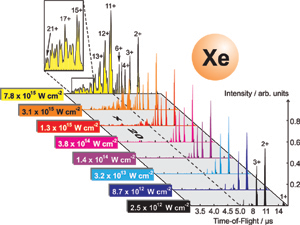Ion time-of-flight mass/charge spectra of xenon taken at a photon energy of 93 eV and different pulse irradiance levels. Each spectrum represents an accumulation over 300 to 500 consecutive FLASH shots at different positions along the photon beam around the microfocus of an EUV multilayer mirror.
Scientists from the Physikalisch-Technische Bundesanstalt (PTB Berlin), Ioffe Physico-Technical Institute (St. Petersburg, Russia), Fraunhofer Inst. f. Ang. Optik u. Feinm. (Jena), and DESY contributed to the study of the photoelectric effect at ultrahigh intensities. The results were recently obtained at FLASH when XUV pulses of 10 fs duration were tightly focused on free Xenon atoms.
How many XUV photons can a Xenon atom absorb within 10 femtoseconds?
For the first time, a multilayer coated EUV mirror focused 13.3 nm radiation from FLASH (corresponding to 93 eV photon energy) to micrometer diameter with petawatts per cm2 irradiance (almost 1016 W/cm2). At these irradiance levels highly charged Xenon ions up to Xe21+ were detected. This means that the outer 5p6, 5s2 and the 4d10 electron shells were completely stripped and in addition three electrons removed from the 4p6 shell. An energy of about 5300 eV is required to produce this charge state, i.e. 57 photons with 93 eV photon energy must have been absorbed by the Xenon atom from the 10 fs XUV pulse. It is hard to imagine that this is a sequential process. However, strong-field ionisation as observed at optical wavelengths seems also to be excluded because the ponderomotive potential at 13.3 nm and 1015 W/cm2 is about 200 meV only.
Therefore, this work may be the starting point for new theoretical work on photon-matter interaction at short wavelengths and high photon intensities with strong impact on x-ray laser science, in general.
The results appeared in Phys. Rev. Lett. (November 2007).
| Further Links |
|






